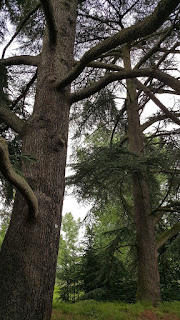Check out the website: https://www.kew.org/


The Royal Botanic Gardens, Kew, struck my grammatical interest as much as their herbarium. Why Kew is referred to as botanic and not botanical confused me, but according to grammar websites, botanic is just a variant of botanical. English is weird.
Anyway, we were first introduced to Andrew Wiltshire, who gave a lecture about Beatrix Potter and her secret life, which mostly stayed hidden because of her secret language. When after five years of decoding, all the secrets were let out. She was an analytical and well-rounded woman, able to draw realistic depictions and study botanical concepts, which could have led to an earlier discovery of penicillin. Unfortunately, she ceased her research because the scientific community, particularly the Linnean Society, rejected her work. She then became successful and more known for Peter Rabbit and her distinct anatomical art of rabbits.
Afterwards, we were toured displays of the Gardens's materials. We did not see their herbarium, but we were told of their uncatalogued collections: 300,000 books/pamphlets, 200,00 artworks, and 7,000,000 archived papers, along with numerous dried plant samples. Fiona Ainsworth led us through the collections and discussed Kew's history and the history of the collections set out. The gardens started as a royal status symbol and began collecting plants from all over the world during the English imperialist period, where the mindset of finding economical and scientific benefit to the country overrode any informational organization until the library began about a hundred years later. Their herbarium, which also includes digitized materials, is about 165 years-old, with the oldest material dating from the 14th century. It was really disappointing we did not see the herbarium in person because I was pretty unenthusiastic about the materials presented. they were mostly artwork, which were lovely, but no dried samples were provided nor pictures of these materials. Rather, we got books, photographs, and letters from others which were involved in botany, such as Charles Darwin or Potter. I never knew a herbarium existed until then, but sadly we were only delivered archival materials which could be found in an art gallery and a conventional archive.
However, my favorite art of the trip was getting lost in the royal gardens. The maps were utterly useless to my spatially dumb mind, but around every corner was something beautiful. And though my legs were in pain by the end of the day, I managed to see about every marker of the map, eventually. I felt in tuned with everything around me, especially when under the cedar trees.





No comments:
Post a Comment